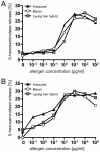Is aboriginal food less allergenic? Comparing IgE-reactivity of eggs from modern and ancient chicken breeds in a cohort of allergic children
- PMID: 21552565
- PMCID: PMC3084253
- DOI: 10.1371/journal.pone.0019062
Is aboriginal food less allergenic? Comparing IgE-reactivity of eggs from modern and ancient chicken breeds in a cohort of allergic children
Abstract
Background: Hen's egg allergy ranks among the most frequent primary food allergies in children. We aimed to investigate sensitization profiles of egg allergic patients and compare in vitro IgE reactivities of eggs from ancient chicken breeds (Araucana and Maran) with those from conventional laying hen hybrids.
Methodology: Egg allergic children (n = 25) were subjected to skin prick test, double blind placebo controlled food challenge, and sensitization profiles to Gal d 1-5 were determined by allergen microarray. IgE binding and biological activity of eggs from different chicken breeds were investigated by immunoblot, ELISA, and mediator release assays.
Principal findings: We found that Gal d 1 and Gal d 2 are generally major egg allergens, whereas Gal d 3-5 displayed high sensitization prevalence only in patients reacting to both, egg white and yolk. It seems that the onset of egg allergy is mediated by egg white allergens expanding to yolk sensitization in later stages of disease. Of note, egg white/yolk weight ratios were reduced in eggs from Auraucana and Maran chicken. As determined in IgE immunoblots and mass analysis, eggs from ancient chicken breeds did not differ in their protein composition. Similar IgE-binding was observed for all egg white preparations, while an elevated allergenicity was detected in egg yolk from Araucana chicken.
Conclusion/significance: Our results on allergenicity and biological activity do not confirm the common assumption that aboriginal food might be less allergenic. Comprehensive diagnosis of egg allergy should distinguish between reactivity to hen's egg white and yolk fractions to avoid unnecessary dietary restrictions to improve life quality of the allergic child and its family.
Conflict of interest statement
Figures




Similar articles
-
Screening for hen's egg and chicken meat specific IgE antibodies in Saudi patients with allergic disorders.Afr Health Sci. 2014 Sep;14(3):634-40. doi: 10.4314/ahs.v14i3.19. Afr Health Sci. 2014. PMID: 25352882 Free PMC article.
-
Ovomucoid (Gal d 1) specific IgE detected by microarray system predict tolerability to boiled hen's egg and an increased risk to progress to multiple environmental allergen sensitisation.Clin Exp Allergy. 2012 Mar;42(3):441-50. doi: 10.1111/j.1365-2222.2011.03915.x. Epub 2011 Dec 14. Clin Exp Allergy. 2012. PMID: 22168465 Clinical Trial.
-
Molecular and immunological analysis of hen's egg yolk allergens with a focus on YGP42 (Gal d 6).Mol Immunol. 2016 Mar;71:152-160. doi: 10.1016/j.molimm.2016.02.005. Epub 2016 Feb 18. Mol Immunol. 2016. PMID: 26897338
-
Hen's Egg Allergy.Chem Immunol Allergy. 2015;101:124-30. doi: 10.1159/000375416. Epub 2015 May 21. Chem Immunol Allergy. 2015. PMID: 26022872 Review.
-
Cracking the egg: An insight into egg hypersensitivity.Mol Immunol. 2015 Aug;66(2):375-83. doi: 10.1016/j.molimm.2015.04.016. Epub 2015 May 18. Mol Immunol. 2015. PMID: 25965316 Review.
Cited by
-
Allergen micro-bead array for IgE detection: a feasibility study using allergenic molecules tested on a flexible multiplex flow cytometric immunoassay.PLoS One. 2012;7(4):e35697. doi: 10.1371/journal.pone.0035697. Epub 2012 Apr 17. PLoS One. 2012. PMID: 22530068 Free PMC article.
-
Screening for hen's egg and chicken meat specific IgE antibodies in Saudi patients with allergic disorders.Afr Health Sci. 2014 Sep;14(3):634-40. doi: 10.4314/ahs.v14i3.19. Afr Health Sci. 2014. PMID: 25352882 Free PMC article.
References
-
- Osterballe M, Mortz CG, Hansen TK, Andersen KE, Bindslev-Jensen C. The prevalence of food hypersensitivity in young adults. Pediatr Allergy Immunol. 2009;20:686–692. - PubMed
-
- Osterballe M, Hansen TK, Mortz CG, Host A, Bindslev-Jensen C. The prevalence of food hypersensitivity in an unselected population of children and adults. Pediatr Allergy Immunol. 2005;16:567–573. - PubMed
-
- Sicherer SH, Sampson HA. 9. Food allergy. J Allergy Clin Immunol. 2006;117:S470–475. - PubMed
-
- Zuidmeer L. You Can't Unscramble an Egg. Or Can You? Int Arch Allergy Immunol. 2011;154:1–2. - PubMed
-
- Everberg H, Brostedt P, Oman H, Bohman S, Moverare R. Affinity Purification of Egg-White Allergens for Improved Component-Resolved Diagnostics. Int Arch Allergy Immunol. 2011;154:33–41. - PubMed
Publication types
MeSH terms
Substances
LinkOut - more resources
Full Text Sources
Research Materials

